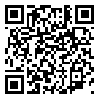Volume 5, Issue 177 (1-2024)
J Except Educ 1402, __(177): 91-91 |
Back to browse issues page
Download citation:
BibTeX | RIS | EndNote | Medlars | ProCite | Reference Manager | RefWorks
Send citation to:



BibTeX | RIS | EndNote | Medlars | ProCite | Reference Manager | RefWorks
Send citation to:
karimimoghadam H, jadidi Z. Analyzing teachers' lived experiences of students'
stubbornness-disobedience phenomenon:
a phenomenological study. J Except Educ 2024; 5 (177) : 6
URL: http://exceptionaleducation.ir/article-1-2587-en.html
URL: http://exceptionaleducation.ir/article-1-2587-en.html
1- allameh tabataba'i university , h_karimimoghadam@atu.ac.ir
2- azad university-bojnourd
2- azad university-bojnourd
Abstract: (912 Views)
Abstract
Background & Purpose: Stubborn-disobedient students start quarrels and argue with their parents and
act in a spiteful manner. The aim of the current research is to analyze the teachers' lived experiences of the
phenomenon of students' stubbornness and disobedience.
Materials and Methods: The research method was based on qualitative approach and phenomenological
method. The statistical population of the research included teachers with teaching experience in exceptional
schools. 8 teachers were selected for the interview with available sampling method. A semi-structured
interview was used to collect data and continued until data saturation, and after recording, the interviews
were converted into text and the main and secondary themes were extracted. Collaizi method was used to
analyze the data.
Results: The three main components are antecedents (problems in interacting with the teacher,
arguments with classmates, hunger, the degree of difficulty of the task and disinterest in the content of the
class), consequences (academic failure, rejection, anger and aggression, and problems in interpersonal
relationships) and controllers (Computer games, punishment, using token and reward, playing, watching
movies and theater, reading stories, sand play and discipline program) were very important findings of this
study.
conclusion: Stubbornness-disobedience has a significant impact on the lack of academic progress and
the occurrence of communication problems in the classroom, and therefore they should be examined,
diagnosed and intervened in a timely and appropriate manner.
Background & Purpose: Stubborn-disobedient students start quarrels and argue with their parents and
act in a spiteful manner. The aim of the current research is to analyze the teachers' lived experiences of the
phenomenon of students' stubbornness and disobedience.
Materials and Methods: The research method was based on qualitative approach and phenomenological
method. The statistical population of the research included teachers with teaching experience in exceptional
schools. 8 teachers were selected for the interview with available sampling method. A semi-structured
interview was used to collect data and continued until data saturation, and after recording, the interviews
were converted into text and the main and secondary themes were extracted. Collaizi method was used to
analyze the data.
Results: The three main components are antecedents (problems in interacting with the teacher,
arguments with classmates, hunger, the degree of difficulty of the task and disinterest in the content of the
class), consequences (academic failure, rejection, anger and aggression, and problems in interpersonal
relationships) and controllers (Computer games, punishment, using token and reward, playing, watching
movies and theater, reading stories, sand play and discipline program) were very important findings of this
study.
conclusion: Stubbornness-disobedience has a significant impact on the lack of academic progress and
the occurrence of communication problems in the classroom, and therefore they should be examined,
diagnosed and intervened in a timely and appropriate manner.
Article number: 6
Type of Study: Original Article |
Subject:
Behavior Disorder
Received: 2023/Mar/Sun | Revised: 2024/Jan/Mon | Accepted: 2023/Sep/Tue | Published: 2024/Jan/Mon | ePublished: 2024/Jan/Mon
Received: 2023/Mar/Sun | Revised: 2024/Jan/Mon | Accepted: 2023/Sep/Tue | Published: 2024/Jan/Mon | ePublished: 2024/Jan/Mon
Send email to the article author
| Rights and permissions | |
 |
This work is licensed under a Creative Commons Attribution-NonCommercial 4.0 International License. |





